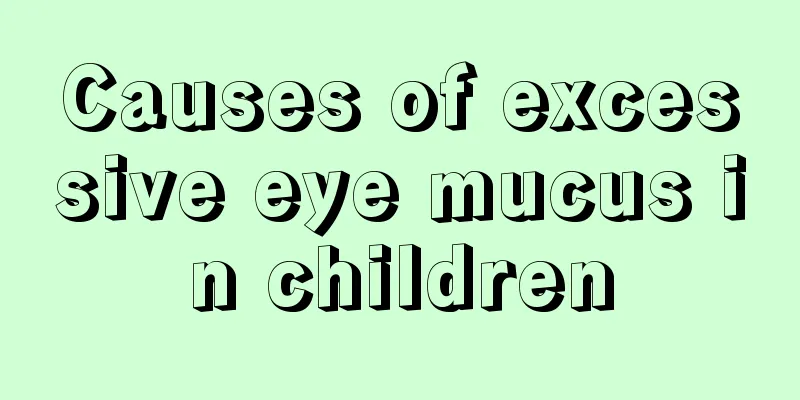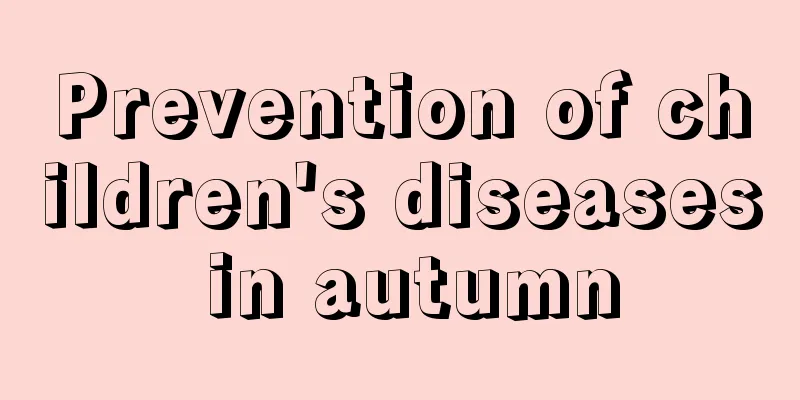Causes of excessive eye mucus in children

|
The problem of excessive eye mucus in children is believed to have troubled many parents. When children have excessive eye mucus, they are inevitably worried and afraid that their children may have some serious problems, and they dare not make a judgment easily. Excessive eye mucus in children not only makes the children feel uncomfortable, but also makes parents feel anxious due to lack of experience. Below are several possible reasons why children have excessive eye mucus and the corresponding solutions. I hope this can help friends who have just become parents. I hope you can come in and take a look. Possibility 1: Neonatal dacryocystitis This disease is caused by blockage of the tear duct and nasolacrimal duct that excrete tears. Because the embryonic residual membrane at the lower end of the nasolacrimal duct has not degenerated, it blocks the lower end of the nasolacrimal duct, and tears and bacteria accumulate in the lacrimal sac under the skin at the inner corner of the eye, causing secondary infection. About 2% to 4% of full-term newborns have this residual membrane, most of which will shrink on their own within 4 to 6 weeks. Solution: Massage the lacrimal sac and nasolacrimal duct from the root of the nose to the tip of the nose to increase the pressure in the duct and promote the rupture of the residual membrane. When bacterial infection occurs, anti-infection treatment is given. If multiple massages and conservative treatments are ineffective, probing can be performed with a probe after anti-infection treatment. Possibility 2: Conjunctival inflammation After the child is born, parents are afraid that the child will catch a cold, so the temperature at home is often high, making it easy for bacteria to multiply. In addition, the newborn will unconsciously rub their eyes with their hands, which can easily lead to symptoms of conjunctivitis such as increased eye secretions and conjunctival congestion. If it is a serious bacterial infection, or occurs after a cold and fever, symptoms such as increased secretions, increased tears, and congestion of the eyes will be more obvious, and may also cause redness and swelling of the eyelid skin. Solution: Topical antibiotic eye drops and eye ointment can improve symptoms, and conjunctival irrigation can help subside inflammation. Before applying eye drops, the child's eyes should be cleared of secretions. If the child also has symptoms such as dry stool, yellow urine, and thick and greasy tongue coating, he or she can be treated with traditional Chinese medicine that clears away heat and fire, and relieves food stagnation. Possibility 3: Gonococcal pyophthalmia This disease is caused by gonococcal infection, with an incubation period of 2 to 4 days. It is often caused by the mother suffering from genital gonorrhea, and the newborn is infected when passing through the birth canal. Both eyes are affected at the same time, showing acute purulent conjunctivitis. Usually the child's eyelids will be extremely red and swollen, almost unable to open, and a large amount of pus-like eye discharge will be produced continuously. If not treated properly, corneal ulcers may occur, leading to corneal perforation and the risk of blindness. Solution: Usually when a newborn is born, the hospital will use 1% silver nitrate solution to drop into the eyes to reduce the infection rate of the newborn. However, newborns delivered in informal hospitals have a greater chance of contracting the disease. The key is to isolate sick children, use medication early and treat thoroughly. Penicillins are effective for this disease. To avoid cross infection, you should go to a regular hospital for systematic treatment to avoid delaying the disease. Possibility 4: Entropion Because some infants have incompletely developed facial bones, especially those with wide and flat noses, the skin of the upper eyelid often extends down to the inner corner of the eye, covering part of the canthus tissue and even part of the sclera, causing epicanthus. Or wrinkles may appear on the skin of the lower eyelid, resulting in lower eyelid folds. ? I believe that parents should know how to deal with the problem of excessive eye mucus in children. I hope these methods can alleviate parents’ worries, solve the problem of excessive eye mucus in children, and make the baby comfortable and clean. Parents can also rest assured and treat the symptoms according to different possible methods. I hope these methods can solve the problem of excessive eye mucus in babies and achieve the desired effect. |
<<: Symptoms of infantile spasms
>>: Attention issues for two-month-old children
Recommend
What to do if your child has a stomachache
Children often have stomachaches because they are...
Symptoms of malnutrition in children
What are the symptoms of malnutrition in children...
Causes and symptoms of stuttering in children
Stuttering is quite common in life. There are man...
What is the height and weight of a 29-month-old baby?
Nowadays, most families have only one child, so p...
What to do if a child has a high fever and diarrhea? Nursing is the key
If a child has diarrhea and fever, it means that ...
Why does my child's vagina smell?
The vagina of a normal person generally has a sli...
What kind of exercise can children do to grow taller?
The growth of children in their childhood is more...
What are the reasons why babies cannot open their eyes?
Mothers are particularly concerned about the heal...
What to do if your child has recurrent bronchial pneumonia
Bronchopneumonia is a relatively common respirato...
The reason why babies sometimes shake their heads
Many people shake their heads. When you shake you...
What causes hard bumps on children's hands?
Children's body resistance is relatively low ...
What is the reason why babies walk with their feet turned inward?
Nowadays, every family with a baby treasures the ...
Treatment of baby's wind-heat cold
Baby wind-heat cold is very common in our daily l...
7 Tips to Deal with Your Child’s Stuttering
1. Speak calmly: Pause frequently and wait for a ...
What causes stomach pain in children?
In our daily life, we often find children sufferi...









